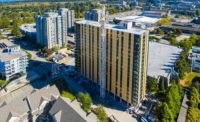The campaign by the Portland Cement Association and the Institute for Building and Home Safety to promote proposed building code changes included in the High Performance Building Requirements for Sustainability 2.0 is not new: The majority of these proposals have been put forward by PCA and the Masonry Alliance, an umbrella group repre-senting all masonry-related trade associations, in each code development cycle since the International Building Code (IBC) was first published in 2000. The Building Owners and Managers Association (BOMA) has and will continue to vigorously oppose this effort.

BURTON
Each and every year, PCA proposals have been soundly rejected by state and local building officials that constitute the voting members of the International Code Council (ICC), which publishes IBC and other model codes.
PCA and IBHS, an organization representing the largest U.S. property/casual insurance companies, produced the requirements and a host of related proposals to change IBC, in their words, to “allow local governments to adopt green building codes that address high performance as well as conventional sustainable features.”
The IBC is not, however, a green building code. Instead, it is the most widely used model building code establishing minimum requirements for all buildings. This not-so-veiled attempt to rewrite the model code seeks to transform it into a far-reaching “stretch” code, well beyond the minimum regulations that jurisdictions have come to regard as a basic building block for construction.
PCA and IBHS are pursuing this self-serving strategy without giving so much as a hint as to the costs associated with the myriad proposed changes, much less the cost-benefit analysis required for the consideration of such sweeping changes.
Partisan Nature
The following are just some of the proposals that specifically benefit PCA and IBHS constituencies, thus highlighting the partisan nature of this campaign.
- Requirements for service-life plans to be provided before applying for a building permit include elements which are either patently unenforceable or impossible to fully determine; nevertheless, they constitute a significant transfer of additional liability to owners.
- Redundant passive fire-protection requirements that provide no significant life-safety benefits but which would result in greatly increased use of masonry products.
- Elimination of dozens of provisions regarding life safety; for example, there is a decades-old provision that recognizes the addition of an automatic sprinkler system justifies commensurate offsets in passive fire-protection requirements.
- Mandatory addition of storm shelters with no evidence the shelters will meet the needs of building occupants in various events; also, it is unclear if their cost is justified.
- Disallowing sprinkler systems specifically designed for residential structures in favor of much more costly systems providing additional property protection with no additional life-safety benefits.
This obvious promotion of specific products over the needs and desires of building owners and occupants should be rejected. If PCA and IBHS want to convince ICC or other code development organizations to create a “stretch” or maximum code to replace the basic building code, let them propose that and justify the concept with cost and benefit specifics.
Absent a comprehensive debate about radically changing the scope and purpose of the minimum model codes—a debate BOMA does not believe the PCA-IBHS initiative can survive successfully—the comprehensive nature of the High Performance Building Requirements for Sustainability 2.0 proposals has no place in the deliberations on modifications to those minimum codes.
Also, the “green” concepts included in these code changes are included already in the draft International Green Construction Code and ASHRAE Standard 189.1, the new commercial green-building model code, neither of which were intended to apply to all buildings and construction projects. That fact alone argues convincingly for treating these proposals as “stretch” code initiatives outside the bounds of the traditional minimum model codes.


Post a comment to this article
Report Abusive Comment